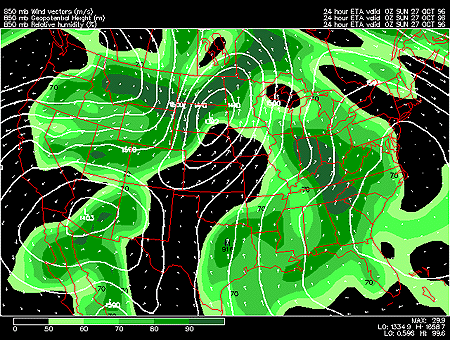
|

This panel shows the 850 mb forecasted fields for geopotential height, relative humidity and wind vectors. 850 mb charts depict conditions in the lower troposphere (roughly 1500 meters).
Geopotential height approximates the actual height of a pressure surface above mean sea-level and is represented by the solid white contours. The geopotential height field is given in meters with an interval of 30 meters between height lines. The locations of surface cyclones and anticyclones hold similar positions in the 850 mb geopotential height field.
Wind vectors provide information about wind direction and wind speed and are drawn here as tiny white arrows. Wind vectors point towards the direction in which the wind is blowing and the longer the wind vector, the stronger the wind. The unit of magnitude for wind speed as depicted by the wind vectors is meters per second.
In this particular image, the important feature is the presence of high relative humidity air over most of the continental United States. Moisture over these areas will allow the possibility of clouds and precipitation to form. Over Kansas, where the air is relatively dry, clouds will most likely not form.
Relative humidity is represented by the color filled regions and the associated values are indicated by the color code located in the lower left corner of the forecast panel. Relative humidities are given in percent with an interval of 10% between the shaded humidity contours. Humidities of 50% and greater are shaded in varying colors of green, while humidities less than 50% are not shaded. The higher the relative humidity, the more moist the air, which is vital for the development of clouds and precipitation.
|
